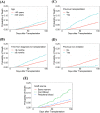Early transplantation-related mortality after allogeneic hematopoietic cell transplantation in patients with acute leukemia
- PMID: 33602150
- PMCID: PMC7891151
- DOI: 10.1186/s12885-021-07897-3
Early transplantation-related mortality after allogeneic hematopoietic cell transplantation in patients with acute leukemia
Abstract
Background: Transplantation-related mortality (TRM) is a major obstacle in allogeneic hematopoietic cell transplantation (allo-HCT). Approximately 60-80% of TRM occurs early, within 100 days of transplantation.
Methods: This was a nationwide population cohort study involving 5395 patients with acute leukemia who underwent allo-HCT between 2003 and 2015. Patient data were collected from the Korean National Health Insurance Service database. We investigated the cumulative incidence rates (CIRs) of early TRM at 50 and 100 days.
Results: The CIRs of early TRM at 50 and 100 days were 2.9 and 8.3%, respectively. There was no decrease in the CIRs of early TRM over time. The early mortality was significantly higher in patients with more than 9 months between the diagnosis and transplantation (CIRs of TRM at 50, 100 days; 6.0, 13.2%), previous transplantations (CIRs of TRM at 50, 100 days; 9.4, 17.2%), and cord blood transplantation (CIRs of TRM at 50, 100 days; 6.1, 8.3%). The early TRM was significantly lower in patients who received iron chelation before transplantation (CIRs of TRM at 50, 100 days; 0.3, 1.8%).
Conclusions: In conclusion, the overall CIR of early TRM was less than 10%. The predictable factors for early TRM included age, time from diagnosis to transplantation, the number of prior transplantations, the graft source, and previous iron chelation therapy.
Keywords: Acute leukemia; Cumulative incidence rates; Hematopoietic stem cell transplantation; Risk factor; Transplantation-related mortality.
Conflict of interest statement
There are no potential competing interests relevant to this article to report.
Financial disclosure statements: All authors have nothing to declare.
Figures


References
-
- Hahn T, McCarthy PL, Jr, Hassebroek A, Bredeson C, Gajewski JL, Hale GA, et al. Significant improvement in survival after allogeneic hematopoietic cell transplantation during a period of significantly increased use, older recipient age, and use of unrelated donors. J Clin Oncol. 2013;31:2437–2449. doi: 10.1200/JCO.2012.46.6193. - DOI - PMC - PubMed
-
- Styczyński J, Tridello G, Koster L, Iacobelli S, van Biezen A, van der Werf S, et al. Death after hematopoietic stem cell transplantation: changes over calendar year time, infections and associated factors. Bone Marrow Transplant. 2020;55:126–136. doi: 10.1038/s41409-019-0624-z. - DOI - PMC - PubMed
-
- Miano M, Labopin M, Hartmann O, Angelucci E, Cornish J, Gluckman E, et al. Haematopoietic stem cell transplantation trends in children over the last three decades: a survey by the paediatric diseases working party of the European group for blood and marrow transplantation. Bone Marrow Transplant. 2007;39:89–99. doi: 10.1038/sj.bmt.1705550. - DOI - PubMed
-
- Cornelissen JJ, Carston M, Kollman C, King R, Dekker AW, Löwenberg B, et al. Unrelated marrow transplantation for adult patients with poor-risk acute lymphoblastic leukemia: strong graft-versus-leukemia effect and risk factors determining outcome. Blood. 2001;97:1572–1577. doi: 10.1182/blood.V97.6.1572. - DOI - PubMed
MeSH terms
LinkOut - more resources
Full Text Sources
Other Literature Sources
Medical

